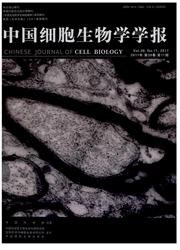

 中文摘要:
中文摘要:
采用慢病毒载体质粒PLJM1将NapsinA基因转染到人肺腺癌细胞——A549细胞中,获得稳定表达NapsinA蛋白的特性并鉴定,通过转化生长因子、B1刺激A549细胞发生上皮-间质转化,体外构建上皮-间质转化模型并鉴定。MTT法检测转基因前后A549细胞在上皮-间质转化过程中生长速率的变化;流式细胞术检测其细胞周期的改变,最后予Western blot检测黏着斑激酶的表达情况,探讨NapsinA基因对A549细胞在上皮-间质转化过程中增殖的影响及其机制。结果表明转染后的A549细胞表达Napsin A蛋白明显增加(P〈0.01);A549细胞发生上皮-间质转化后细胞E钙蛋白表达下调(P〈0.01),I型胶原表达上调(P〈0.01);转基因细胞在体外上皮一间质转化模型中增殖速度减慢(P〈0.05),且细胞周期被阻滞在G,期(P〈0.01),其表达整合素信号传导通路的基础分子—-黏着宽激酶的量显著下降(P〈0.01)。提示NapsinA基因可以抑制A549细胞在上皮-间质转化过程中的进一步增殖,其机制可能与抑制整合素信号传导通路有关。
 英文摘要:
英文摘要:
A recombinant lentiviral plasmid PLJM1-Napsin A was constructed and transfected into lung adenocarcinoma cell A549. Western blot assay was used to identify the stable expression of Napsin A protein. Ephethlial-mesenchymal transition model was established in vitro by the A549 cells treated with transforming growth factor beta-1. The cell proliferation was detected by MTT assay. The alteration of cell cycle were determined by flow cytometry. Then the expression of focal adhesion kinase were determined by Western blot. This study was to investigate the effect of Napsin A gene on the proliferation in ephethlial-mesenchymal transition of cell A549 and its mechanism. In vitro experiment showed A549 cell line with Napsin A gene infection was constructed successfully and Napsin A protein was expressed stably (P〈0.01). Transforming growth factor beta-1 induced ephethlial-mesenchymal transition in A549 cells, as demonstrated by significant reduction of E-cadherin (P〈0.01) as well as upregulation of collagen type I (P〈0.01). Also transforming growth factor beta-1-inuced cell proliferation was inhibited by Napsin A (P〈0.05). Further study demonstrated that Napsin A can cause G0/G1 arrest (P〈0.01)and inhibit expression of focal adhesion kinase (P〈0.01), a key protein in integrin signaling pathway, in vitro ephethlial-mesenchymal transition model. Sustained Napsin A expression in A549 cells can inhibit the ephethlial-mesenchymal transition-induced proliferation. This may be due to blocked integrin signaling pathway by Napsin A.
 同期刊论文项目
同期刊论文项目
 同项目期刊论文
同项目期刊论文
 期刊信息
期刊信息
